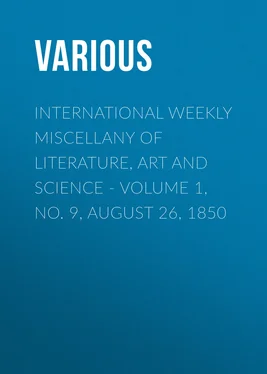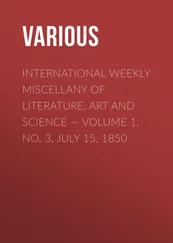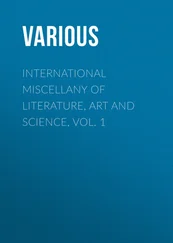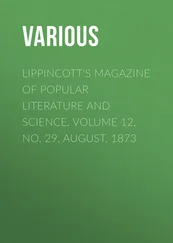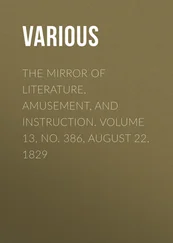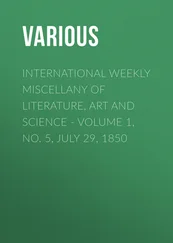Various - International Weekly Miscellany of Literature, Art and Science - Volume 1, No. 9, August 26, 1850
Здесь есть возможность читать онлайн «Various - International Weekly Miscellany of Literature, Art and Science - Volume 1, No. 9, August 26, 1850» — ознакомительный отрывок электронной книги совершенно бесплатно, а после прочтения отрывка купить полную версию. В некоторых случаях можно слушать аудио, скачать через торрент в формате fb2 и присутствует краткое содержание. Жанр: foreign_antique, periodic, foreign_edu, на английском языке. Описание произведения, (предисловие) а так же отзывы посетителей доступны на портале библиотеки ЛибКат.
- Название:International Weekly Miscellany of Literature, Art and Science - Volume 1, No. 9, August 26, 1850
- Автор:
- Жанр:
- Год:неизвестен
- ISBN:нет данных
- Рейтинг книги:4 / 5. Голосов: 1
-
Избранное:Добавить в избранное
- Отзывы:
-
Ваша оценка:
- 80
- 1
- 2
- 3
- 4
- 5
International Weekly Miscellany of Literature, Art and Science - Volume 1, No. 9, August 26, 1850: краткое содержание, описание и аннотация
Предлагаем к чтению аннотацию, описание, краткое содержание или предисловие (зависит от того, что написал сам автор книги «International Weekly Miscellany of Literature, Art and Science - Volume 1, No. 9, August 26, 1850»). Если вы не нашли необходимую информацию о книге — напишите в комментариях, мы постараемся отыскать её.
International Weekly Miscellany of Literature, Art and Science - Volume 1, No. 9, August 26, 1850 — читать онлайн ознакомительный отрывок
Ниже представлен текст книги, разбитый по страницам. Система сохранения места последней прочитанной страницы, позволяет с удобством читать онлайн бесплатно книгу «International Weekly Miscellany of Literature, Art and Science - Volume 1, No. 9, August 26, 1850», без необходимости каждый раз заново искать на чём Вы остановились. Поставьте закладку, и сможете в любой момент перейти на страницу, на которой закончили чтение.
Интервал:
Закладка:
Various
International Weekly Miscellany of Literature, Art and Science - Volume 1, No. 9, August 26, 1850
NUMISMATIC ARCHÆOLOGY
A magnificent work 1 1 Trésor de Numismatique et de Glyptique; ou, Recueil Général de Médailles, Monnaies, Pierres Gravées, Sceaux, Bas-reliefs, Ornements, &c. Paris, 1850.
upon this subject has just been completed in Paris, where it was commenced fifteen years ago. It was begun under the auspices of M. Paul Delaroche and M.C. Lenormand, member of the Institute, and well known already as one of the first authorities in the numismatic branch of archæology. Some faint idea of the greatness of the task may be given by stating that it embraces the whole range of art, from the regal coins of Syracuse and of the Ptolemies, down to those of our day; that such a stupendous scheme should ever have been carried into execution is not solely due to the admirable ease and fidelity, with which the "Collas machine" renders the smallest and the largest gems of the antique: but to him who first felt, appreciated, and afterward promoted its capabilities in this labor of love, M.A. Lachevardiere. Comparisons and contrasts, which are the life of art, though generally confined to the mental vision, are not the least of the recommendations of this vast work. For the first time have the minor treasures of each country been brought together, and not the least conspicuous portion are those from the British Museum and the Bank of England.
Whether we consider the selection of these monumental relics, the explanatory letterpress, or the engravings which reproduce them, we are struck by the admirable taste, science, and fidelity with which the largest as well as the smallest gems have each and every one been made to tally in size with the originals.
The collection of the "Trésor de Numismatique et Glyptique," consisting of twenty volumes in folio, and containing a thousand engraved plates in folio, reproduces upward of 15,000 specimens, and is divided into three classes—1st. The coins, medals, cameos, &c. of antiquity; 2d. Those of the middle ages; lastly, those of modern times. The details of this immense mass of artistic wealth would be endless; but these three classes seem to be arranged according to the latest classification of numismatists.
In the first class may be noticed—1. The regal coins of Greece, which contains, beside the portraits of the Greek Kings, to be found in Visconti's "Iconographie," copied from medals and engraved gems, all the coins bearing the Greek name of either a king, a prince, or a tyrant, and every variety of these types, whether they bear the effigy of a prince, or only reproduce his name. To the medals of each sovereign are joined the most authentic and celebrated engraved gems of European cabinets. Next come the series of portraits of the Roman emperors and their families, with all the important varieties of Roman numismatics, amongst which will be found the most celebrated coins of France, Vienna, Dresden, Munich, Florence, Naples, St. Petersburg, Weimar, &c.; and, moreover, those medallions which perpetuate great events. These two volumes contain eight-fold more matter than the great work of Visconti.
In the second class, containing the works of the middle ages, and showing the uninterrupted progress of the numismatic art down to modern times, and forming alone fourteen volumes, we find the source which the French artists and men of letters have studied with such predilection. First in order are the Italian medals of the fifteenth and sixteenth centuries, chiefly by the famous Victor Pisano, a Veronese, whom Nasari has so much lauded. The scholars and imitators of Pisano also produced works as interesting as historical documents as they are admirable in workmanship. Here also will be found the French and English seals, in which the balance of skill in design and execution is acknowledged to be in our favor.
Less barbarous, and indeed perfect works of art, in character of costume and visage, are the medals struck in Germany during the sixteenth and seventeenth centuries, when the influence of Albert Durer and his school was strongly felt. And finally, relics of ornamental art of different nations and epochs.
In the third class, two parts only are devoted to contemporary art; the medals illustrative of the French revolution of 1789; those of the "Empire" and of the Emperor "Napoleon;" generally smacking of the florid and corrupt taste of that period, they are nevertheless curious as being often the sole evidence of the facts commemorated. There is, however, a manifest improvement in the late ones, and in them may be traced the transition from the independent ideas of the revolution to the subsequent submission to one man: and not less striking is the transition from a slip-shod style of art to a pedantic imitation of the antique. The "Trésor de Numismatique et de Glyptique" is the most scientific and important work of art which has been executed and achieved of late years in France. Our great public libraries may be proud of possessing so rich, so valuable, and so curious a collection.
Most lovers of art have their favorite periods and well-beloved masters, but in this varied range of excellence it is difficult which to select for preference and admiration. The cameos have a beauty and finesse which far surpass that of busts and statues; they evince the skill of grouping, which, with rare exceptions, such as the Niobe and Laocoon, is seldom aimed at in the more important pieces of sculpture. Cameos, moreover, let us, as it were, into the secrets of indoor life. To these considerations we may add that these gems have had an immense influence on French modern art. The "Apotheosis of Augustus" especially, known to antiquarians as the "Agate of Tiberius," the largest cameo in the world, and beautifully engraved the size of the original in this collection, may be traced in more than one of their late compositions.
It is said that large medallions are a sign of taste either in the medalist or the monarch he is supposed to honor; if so, Dupré and Varin have drawn a thick vail over the effulgence of Louis XIV. We would not, however, lose their wigs and smiles for a world of historiettes.
But it is to be remembered that the more names are blazoned on works of art, the more art becomes deteriorated. In this respect the present collection shows the rapidly progressive march of this evil through twenty-five centuries—a most instructive subject of contemplation.
THE CSIKOS OF HUNGARY
Of the chivalry, the gallantry, the splendor, the hospitality, the courage, and the love of liberty of the Hungarian noble or gentleman, no one doubts. Of his ideas of true constitutional freedom, or the zeal with which that or Hungarian independence has been maintained first through Turkish, and then German domination for some hundred years past, doubts may be entertained. Neither do the Hungarian peasantry or people reflect high credit on their "natural superiors." Something should be deducted for the forced vivacity and straining after effect of the littérateur; but this sketch of a large class of peasantry from Max Schlesinger's "War in Hungary," just published in London, must have some foundation in truth—and very like the Red Indians or half-breeds of Spanish America the people look.
"The Csikos is a man who from his birth, somehow or other, finds himself seated upon a foal. Instinctively the boy remains fixed upon the animal's back, and grows up in his seat as other children do in the cradle.
"The boy grows by degrees to a big horse-herd. To earn his livelihood, he enters the service of some nobleman, or of the Government, who possess in Hungary immense herds of wild horses. These herds range over a tract of many German square miles, for the most part some level plain, with wood, marsh, heath, and moorland; they rove about where they please, multiply, and enjoy freedom of existence. Nevertheless, it is a common error to imagine that these horses, like a pack of wolves in the mountains, are left to themselves and nature, without any care or thought of man. Wild horses, in the proper sense of the term, are in Europe at the present day only met with in Bessarabia; whereas the so-called wild herds in Hungary may rather be compared to the animals ranging in our large parks, which are attended to and watched. The deer are left to the illusion that they enjoy the most unbounded freedom; and the deer-stalker, when in pursuit of his game, readily gives in to the same illusion. Or, to take another simile, the reader has only to picture to himself a well-constituted free state, whether a republic or a monarchy is all one.
Читать дальшеИнтервал:
Закладка:
Похожие книги на «International Weekly Miscellany of Literature, Art and Science - Volume 1, No. 9, August 26, 1850»
Представляем Вашему вниманию похожие книги на «International Weekly Miscellany of Literature, Art and Science - Volume 1, No. 9, August 26, 1850» списком для выбора. Мы отобрали схожую по названию и смыслу литературу в надежде предоставить читателям больше вариантов отыскать новые, интересные, ещё непрочитанные произведения.
Обсуждение, отзывы о книге «International Weekly Miscellany of Literature, Art and Science - Volume 1, No. 9, August 26, 1850» и просто собственные мнения читателей. Оставьте ваши комментарии, напишите, что Вы думаете о произведении, его смысле или главных героях. Укажите что конкретно понравилось, а что нет, и почему Вы так считаете.
